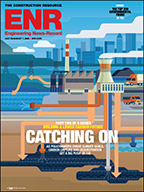Of the 190 firms that offered a forecast for environmental services markets in the next 12 months, 99 anticipated domestic markets would be better, 21 said they would be worse, and 67 expected no change. Among those looking at international markets, 77 expected them to be flat, but only four predicted any worsening. “Currently, the market is still very bumpy,” says PC Construction's Bernhardt. “The next 18 to 24 months will still be very choppy, and I don't believe [the market] will correct itself. It's a risky business.”
George J. Pierson, president and CEO of Parsons Brinckerhoff, thinks the environmental services business has been hurt by the lack of a highway transportation bill and federal climate-change policy. But, he notes, about 10% of local governments are “pursuing climate-change mitigation and adaptation despite limited federal legislation and direction.” With unclear client needs, however, he sees a challenge in anticipating the scope and timing of the technical investments his firm should make in this emerging area.
At the June meeting of the American Water Works Association, participants learned about technology that can detect in drinking water the presence of pharmaceuticals, personal-care products and other “endocrine disruptors,” sometimes in very minute amounts. However, Dan McCarthy, president and CEO of the global water business at Black & Veatch, wonders if water utilities were to make the technology investment, “what kind of benefit are you going to get for the [human] population?”
Tommy Holmes, AWWA legislative director, said that the U.S. Environmental Protection Agency currently is addressing regulating substances such as chromium-6 and perchlorate on a contaminant-by-contaminant basis. But he said wholesale reauthorization of the Safe Drinking Water Act is unlikely in the near term, “unless we get a drought of biblical proportions” that would require “a re-evaluation of water policy on a comprehensive basis.” There is also debate over whom should bear the responsibility for treating and removing chemicals and other substances in the water—drinking-water utilities or wastewater utilities?
Robert Uhler, CEO of MWH, predicts the firm's revenue will increase by at least 25% this year. He notes new alternative-energy laws requiring utilities to have a percentage goal of sustainable energy by a certain date. These laws are pushing for more required management of water to balance hydropower as a backup energy source for intermittent wind and sun power. He says the firm has boosted its management consulting practice by helping state and local governments use constrained funding more productively.
Neno Duplan, CEO of environmental information management firm Locus Technologies, anticipates a 30% revenue rise this year from helping corporations manage their growing amount of environmental data through cloud-based technology. The company manages data at 30% of U.S. commercial nuclear reactors and expects that percentage to increase following the Fukushima accident in Japan in March.
“We see the triple play in the software market—water, energy and environment—interwoven in the cloud. Think of it as an environmental enterprise-resource-planning system,” according to Duplan. “Companies want data ownership. Most U.S. companies are still flying blind when it comes to managing their environmental liability because the data is not integral to daily functioning, and the quantities and complexities of data produced are enormous.”
Staffing up to manage the challenges of the environmental marketplace is another factor confronting the Top 200 environmental firms. “As an environmental sciences firm, we have had to work hard to find experienced operations and program managers who can deliver high- quality service to our clients,” says Pamela S. Hall, president of Normandeau Associates Inc. “We are also finding it a challenge to identify personnel who have combined environmental science and technology backgrounds needed to continue to integrate technology into all our services.”
Other Top 200 CEOs worry about continuing commoditization of the environmental services profession. Says Bill Siegel, CEO of Kleinfelder, “There is some talk that many portions of the environmental market have matured to the point where services to the market are a commodity. Certainly, many clients are behaving that way and are even using the economic downturn to reduce their costs and risks. We don't follow this line of thinking, but there is no denying that there are many more situations where cost, not quality or competence, seems to be the deciding factor in decisions from project owners.”







Post a comment to this article
Report Abusive Comment